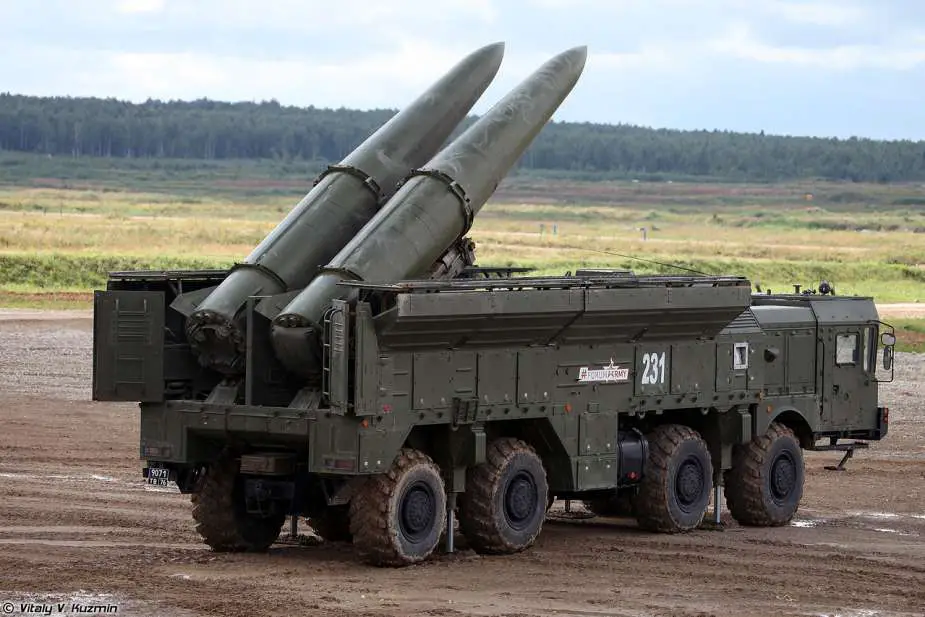New Belarus military doctrine includes deployment of tactical nuclear weapons
On January 16, 2024, Belarusian President Alexander Lukashenko convened a Security Council meeting to address national security matters. The meeting focused on two key strategic planning documents: the new Military Doctrine, which includes the option to employ tactical nuclear weapons (TNW), and the draft National Security Concept.
Follow Army Recognition on Google News at this link

The Iskander-M missiles received by Belarus from Russia are believed to have the capability to carry a nuclear warhead (Picture source: Vitaly Kuzmin)
During the meeting, President Lukashenko emphasized the importance of the updated National Security Concept and Military Doctrine in addressing current security challenges. He expressed concerns about the resurgence of military force in international relations and noted that many assessments and forecasts from these documents have already begun to materialize.
The decision to develop a new edition of the Military Doctrine came after the approval of the revised National Security Concept in February 2023. The new Military Doctrine accounts for emerging military threats and doctrines, updates responses to contemporary military conflicts, and maintains Belarus's defensive stance while emphasizing its determination to prevent external interference or military aggression.
This updated military doctrine includes the option to employ tactical nuclear weapons on Belarusian soil, as confirmed by Belarusian Defense Minister Viktor Khrenin on January 16. Belarusian Security Council Secretary Alexander Volfovich suggested that this change in Belarus's military doctrine is reportedly a response to perceived aggression by neighbors, particularly Poland, which prompted the strengthening of their military posture.
For instance, on November 16, 2023, Army Recognition reported that the rocket artillery brigade of the Armed Forces of Belarus received an upgraded batch of Polonez-M 301 mm multiple launch rocket systems (MLRS). Belarus's deployment of these Polonez-M MLRS is seen as a response to Poland's acquisition of the American M142 HIMARS.
This new military doctrine follows an agreement signed in May 2023 between Russian Defense Minister Sergei Shoigu and his Belarusian counterpart Khrenin, involving the transfer of tactical nuclear weapons to Belarus. Russian leader Vladimir Putin confirmed that the transfer process commenced in June, with Belarusian President Alexander Lukashenko stating in late December that it had been completed.
Before the dissolution of the Soviet Union, Belarus hosted both tactical and strategic nuclear weapons. However, after gaining independence, Belarus transferred these weapons to Moscow. In March 2023, Russian President Vladimir Putin announced plans to relocate a portion of the tactical nuclear weapons to Belarus, citing concerns over the United States' deployment of nuclear warheads in European Union countries.
The specifics of the proposed doctrine, including the number of tactical nuclear weapons Belarus currently possesses and their potential use, remain undisclosed. Tactical nuclear weapons are designed for battlefield deployment, with a range of up to 500 kilometers when launched from land and up to 600 kilometers when launched from air or sea, as detailed by the Nuclear Threat Initiative think tank.
On July 28, 2023, the Army Recognition editorial team reported the construction of a new garage facility in Belarus, suspected to house the Iskander-M missile launchers previously received from Russia. These launchers are believed to have the capability to carry nuclear warheads.
Additionally, on August 31, 2023, Army Recognition reported that Russia had delivered a new batch of at least 10 Iskander-M ballistic missile vehicles to Belarus. These vehicles were transported by train from Kapustin Yar in the Astrakhan region of Russia to the Asipovichy station in the Mohyla region of Belarus. Reports indicate that the Iskander-M ballistic missile systems have been integrated into the Belarusian Armed Forces, with additional shipments of Iskander missiles anticipated to arrive in Belarus.
Belarus has also recently reviewed and updated another of its strategic documents, the National Security Concept. The updated Belarus National Security Concept for 2023 reflects evolving trends by broadening the scope of national security areas and incorporating constitutional provisions concerning political, economic, social, scientific, and technological security. It also introduces the term "electoral sovereignty" for the first time and outlines mechanisms for its preservation.
Sections II and III of the document have undergone substantial revisions to align with contemporary global trends, clarify national interests, and identify threats to national security in various domains. Sections IV and V elaborate on the goals, objectives, and principles of national security and strategies for countering perceived internal and external threats. The document expands its coverage of scientific, technological, information, and military security aspects and emphasizes indicators for assessing national security.
According to new Belarus Constitution rules, both the draft National Security Concept and the Military Doctrine of Belarus will now require approval from the All-Belarusian People's Assembly. This approval comes at a time when the world contends with numerous regional conflicts, including 57 that escalated to military confrontations in 2023, according to the International Institute for Strategic Studies in London.
- Hits: 2832
















